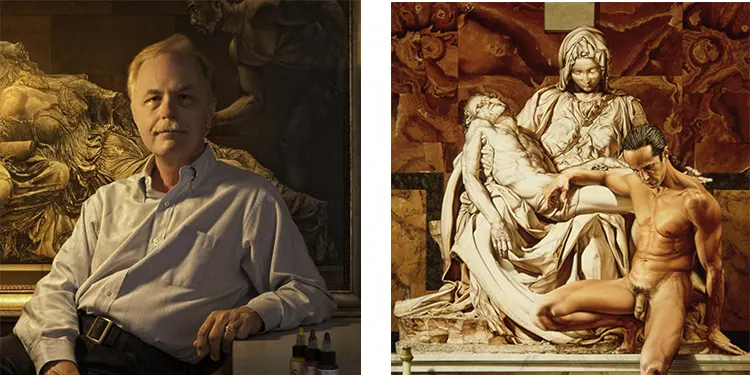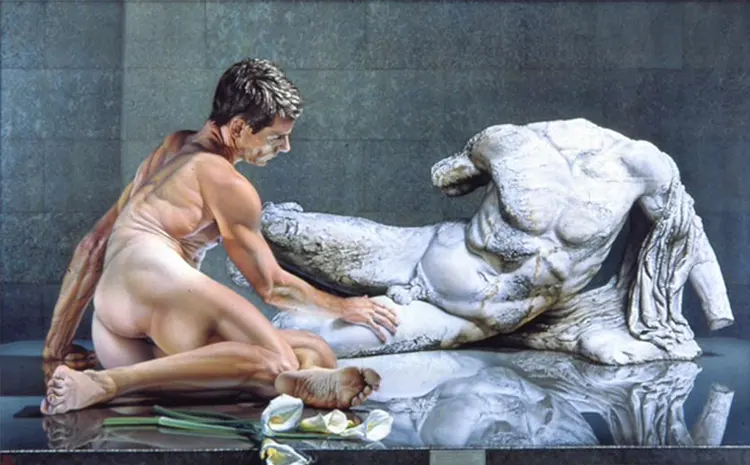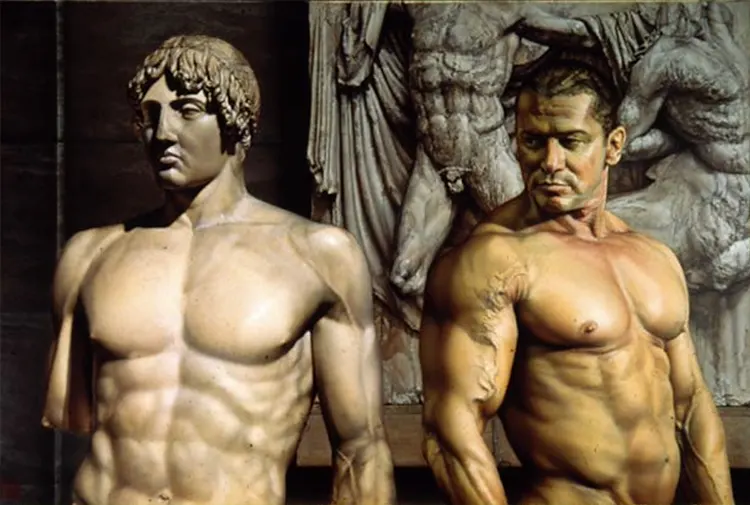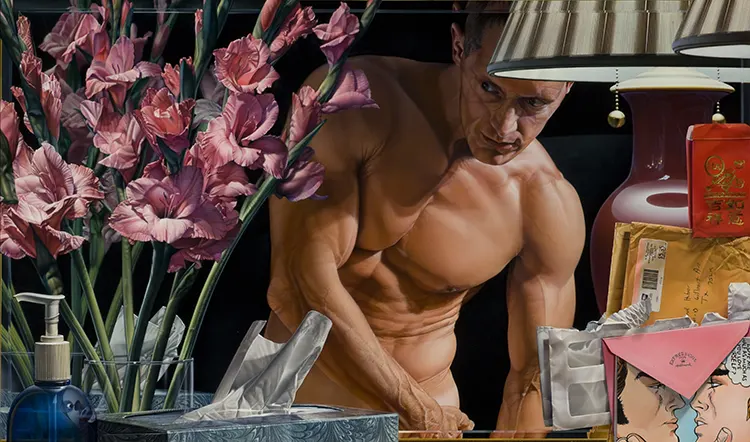“I have always been excited by the idea of trompe l’oeil paintings in which everyday objects are depicted life-sized and presented in a self-contained shallow space.”
The Midwestern Beginnings
Gerard Huber‘s journey into the world of art began in the heartland of America, Waterloo, Iowa, where he was born in 1949. His formative years were steeped in the traditions of Catholic education, a background that shaped not only his moral compass but also his artistic inclinations. Despite his desire to continue this educational path in college, Huber found himself enrolling at the University of Northern Iowa (UNI), influenced by its strong reputation in the arts and its proximity to home. His early exposure to art, particularly through his involvement with the Waterloo Municipal Gallery, fostered a connection with UNI’s art faculty, laying the foundation for his future studies in Fine Arts.
The cultural landscape of the Midwest, home to renowned Social and Regional Realist artists like Grant Wood, Thomas Hart Benton, and John Stuart Curry, significantly influenced Huber. Their realistic portrayal of subjects resonated with Huber, mirroring his own upbringing and shaping his perception of contemporary art. This alignment with realism did not restrict his creative aspirations to religious themes, but it certainly imbued his work with a moralistic and inspirational essence. This early inclination towards realism and moral themes was a precursor to the distinctive style Huber would later develop in his artistic career.

Gerard Huber: Educational Pursuits and Artistic Evolution
Gerard Huber’s artistic journey took a significant turn following his undergraduate studies. Contemplating a religious vocation, he joined the Brothers of Holy Cross at Notre Dame University in 1971. This period of introspection included studies in Contemporary Theology and Figure Drawing, but it ultimately led Gerard Huber to realize that a religious life was not his calling. This revelation steered him towards exploring graduate programs in art, culminating in his acceptance into the prestigious Cranbrook Academy of Art in Michigan. There, under the tutelage of George Ortman, Gerard was encouraged to delve deeper into the purpose and motivation behind his art, a process that profoundly influenced his approach to painting.
At Cranbrook, Huber’s artistic identity underwent a transformation. The introduction to the airbrush by a fellow student opened up new avenues of expression for him. This tool, which he adopted as his primary painting instrument, allowed Huber to explore and refine his technique, marking a pivotal moment in his artistic development. This choice of tool was not just a practical decision but a reflection of Gerard’s evolving artistic vision and his pursuit of a medium that could accurately convey his ideas.
Upon graduating in 1975, Huber embarked on a 47-year-long teaching career at East Texas State University, now Texas A&M University-Commerce. His dedication to teaching – spanning from undergraduate courses in two-dimensional design and color theory to guiding graduate students in understanding their creative impulses – paralleled his commitment to his own artistic pursuits. This dual role of educator and artist allowed Gerard Huber to continuously develop his craft while influencing a new generation of artists. His career at the university exemplifies his passion for both art and education, illustrating how his journey has been as much about imparting knowledge as it has been about his personal artistic exploration.

Gerard Huber: The Genesis of an Artistic Identity
Gerard Huber’s artistic journey is a compelling tale of inspiration and destiny. As a young child, Huber found his first artistic muse in his father, who skillfully drew cartoon characters from the Sunday newspaper. This experience was not only awe-inspiring but also set a benchmark for Huber’s own aspirations in art. His sense of connection to the art world deepened when he discovered the works of the German Renaissance artist Wolf Huber. Sharing a surname with this renowned artist seemed like a sign, reinforcing Huber’s burgeoning passion for art.
The artistic journey of Gerard Huber took a more formal turn in sixth grade when his talent was recognized by his father and the nuns at his school, leading to private after-school art lessons. This early encouragement and formal training laid the groundwork for his artistic development. It wasn’t just about learning techniques; it was about nurturing a passion that was already deeply ingrained in him. This phase of his life marks the beginning of his journey from a young boy enamored with drawings in a newspaper to an artist in the making, setting the stage for a lifetime dedicated to art.

Gerard Huber: Superrealism and Artistic Themes
Gerard’s artistic style, which he classifies as Superrealism, is a blend of meticulous planning and creative spontaneity. He doesn’t simply replicate photographs; he transforms them into intricate compositions that communicate deeper meanings. Huber begins with a conceptual vision, gathering separate photographic elements that align with his thematic intentions. These elements are then projected and rearranged on a panel, where Huber’s imagination and skill converge to bring his vision to life. His approach to Superrealism goes beyond technical replication; it involves a deliberate manipulation of reality, where he adjusts colors, lighting, and details to match his artistic intent.

Throughout his career, Gerard Huber has explored various themes, initially perceiving himself as a painter of objects. He found excitement in still life, using objects to weave stories and convey symbolic meanings. However, a retrospective examination of his work revealed a surprising preference for figurative pieces over still lifes. This insight prompted a shift in focus, leading him to explore figures within interior spaces, allowing him to marry his interest in painting objects with his newfound fascination with the human form. This evolution in thematic focus highlights Gerard’s willingness to introspect and adapt his artistic pursuits, ensuring his work remains dynamic and reflective of his personal growth.






